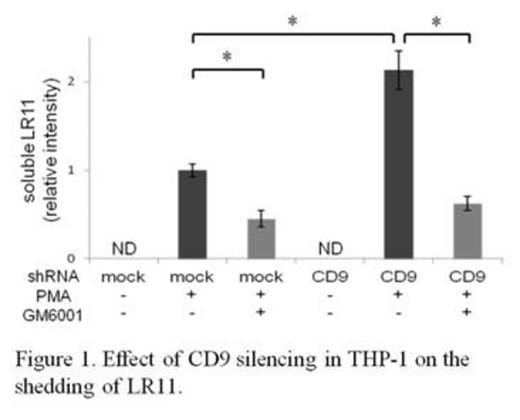Abstract
LR11, which is also known as SorLA or SORL1, is a type-I membrane protein from which a large extracellular part, soluble LR11 (sLR11), is released by proteolytic shedding. We have demonstrated that serum sLR11 levels are significantly elevated in patients with acute leukemia and that sLR11 levels are associated with the peripheral blast percentage (Sakai et al. Clin Chim Acta. 2012). In addition, we found that high sLR11 levels have a significant negative prognostic impact on progression-free survival in patients with follicular lymphoma (FL; Kawaguchi et al. Br J Haematol. 2013). In this FL analysis, the immunohistological intensity of LR11 in lymph nodes of FL patients did not show a significant association with serum sLR11 levels. Therefore, a shedding mechanism is presumed to play a key role in the functions of LR11. A disintegrin and metalloproteinase 17 [ADAM17, also known as tumor necrosis factor (TNF)-α converting enzyme (TACE)] has been identified as the enzyme that cleaves TNF-α from its transmembrane precursor form, and it has been found to cleave the ectodomains of other cell surface proteins. LR11 is also shed by ADAM17. Tetraspanin CD9 has been recently shown to inhibit the shedding activity of ADAM17. Therefore, we investigated the role of CD9 in sLR11 release.
First, we examined the gene expression levels of LR11 by quantitative real-time PCR and the cell surface expression of LR11 and CD9 by flow cytometric analysis in normal human peripheral-blood mononuclear cells (PBMCs). Second, we investigated the cellular expression and the released levels of LR11 and cellular CD9 in THP-1 monocytes, phorbol 12-myristate-13-acetate (PMA)-induced THP-1 macrophages (PMA/THP-1), and the B lymphoblastoid cell line CCRF-SB by immunoblot analysis. Furthermore, to assess the relationship between LR11 and CD9 in PMA/THP-1, we performed double immunofluorescence staining of these molecules followed by confocal microscopy analysis. Third, we examined the effects of ectopic neoexpression of CD9, anti-CD9 mAbs, and CD9 silencing. THP-1 cells stably interfered with CD9 were generated by the transfection of the shRNA expression vector that is specific for CD9.
The gene expression levels of LR11 were significantly higher in CD3+ T cells than in CD14+ monocytes, and there was no difference between monocytes and CD19+ B cells. However, LR11 was only expressed on the cell surface of monocytes in normal PBMCs. CD9 was broadly expressed on the cell surface of every PBMCs. Because it has been reported that CD9 associates with ADAM-17 on the cell surface, we hypothesized that CD9 associates with the shedding of LR11 on the cell surface. To verify this hypothesis, we chose the monocytic cell line THP-1 because monocytes have both LR11 and CD9 on their surface. In addition, because the gene expression levels of LR11 were significantly higher in human monocyte-derived macrophages than that in monocytes, we investigated the levels in PMA/THP-1. LR11 was not expressed or released in undifferentiated THP-1 cells, but it was expressed or released in differentiated PMA/THP-1. CD9 was poorly expressed in THP-1 cells, and the CD9 expression levels were increased in PMA/THP-1. The confocal microscopy analysis showed colocalization of LR11 and CD9 proteins in PMA/THP-1. We next investigated the effects of ectopic neoexpression of CD9 in CD9-negative cells, neutralizing anti-CD9 mAbs (clone ALB-6) in CD9-positive cells, and CD9 silencing in THP-1 on the shedding of LR11. When CCRF-SB, LR11-positive and CD9-negative cells were transiently overexpressed with CD9, the amount of sLR11 released from CD9-overexpressing cells was decreased compared with that from control cells. The amount of sLR11 released from LR11-transfected THP-1 cells that were cultured with ALB-6 was significantly increased compared with that cultured with an isotypic control antibody. The PMA-stimulated release of sLR11 was significantly increased in CD9 shRNA-interfered THP-1 cells compared with cells that were transduced with the control shRNA. The increase in CD9 shRNA-interfered THP-1 was nullified by treatment with the metalloproteinase inhibitor GM6001 (Figure 1).
These results suggested that the tetraspanin CD9 inhibits ADAM17-mediated LR11 shedding in leukemia cells and that it may have a role in controlling the function of LR11.

No relevant conflicts of interest to declare.
Author notes
Asterisk with author names denotes non-ASH members.

This feature is available to Subscribers Only
Sign In or Create an Account Close Modal